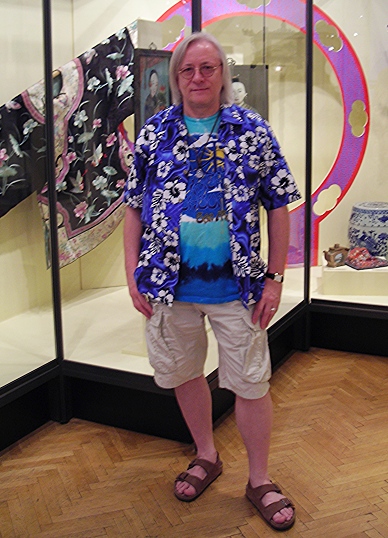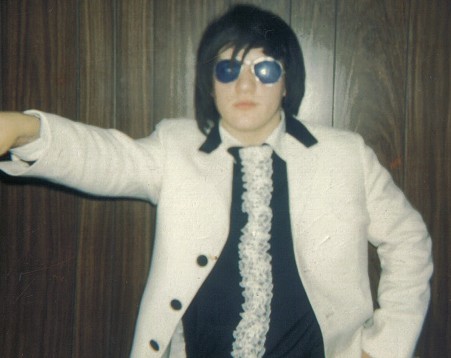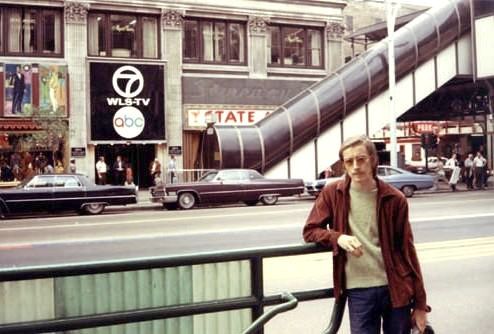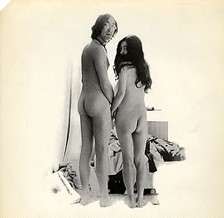After turning on to The Beatles many guys started wearing long hair and Mod fashions in 1964. Before World War II, artists and spoiled boys from good homes often wore long hair. And in the 1960s long hair became a symbol of spoiled American kids' rebellion against the mainstream culture. British fashions were called Mod fashions and often came from Carnegie Street and West End of London. British bands dressed in Mod fashions and had their long hair styled by man's hairstylists. You'll find typical examples of those fashions on Hendrix's album covers, The Beatles' S. Pepper's Lonely Hearts Club Band album cover, Cream's Disraely Wheels and many other early British and American band photos. More recently, Mod fashions are also found in Austin Powers' movies. Below is a photo of my Cousin Stanley from Milwaukee, Wisconsin (1967). He was a drummer with The London Beats. Before that, he played with the warm-up band for The Rolling Stones first concert in Milwaukee. Stan dressed in Mod clothes that he got on Carnegie Street in London.
American hippie fashions replaced British
Mod fashions. Hippies didn't really have any defined
fashion besides boy's long hair, beads from India or
American Indian beads, and colorful shirts, tight jeans,
and also shrinkable jeans, which were later replaced by
bellbottoms after 1969. The so called "Hippie
Fashion" was to be who you are, and to do what you
wanted to do. So, the idea was to wear whatever turned
one on...
My favorite Hairstylist As some
hippies found employment and started earning a living
they started functioning in society or the rat race. Then
some of us became more fashion conscious. But getting
that groovy hippie look was not that easy. As a rule, we
did not follow any fashions rules and become our own
fashion designers. So, many hippies created their own
designs on what they could manage. But, it was not until
after starting my first job that I was able to buy the
more expensive things and to do the things I wasn't able
to do before. One of the things I wasn't able to do was
to visit a good Hairstylist to get that ďhavenít had
a haircut" look like many stars had in those days. I
guess that was the thing to do since the 1960s and
especially the 1970s when men's long hair fashions became
fashionable around the world. Naturism I've spent
several years at naturist beaches, evening campfires,
Volleyball games and met many wonderful naturists in
Europe, and grown to like the lifestyle before problems
with the ozone layer spoiled the fun. Nudists have no
problems with clothes and fashions. After the first day
or two in such an environment one stops judging others by
what they have on. I think that the hippy movement and
also the Rainbow movement were/ are also efforts to bring
about such peaceful, free and open spirit to textilers -
those folks that wear clothes everyday as the naturists
share. So, having lived without clothes and many false
limitations for a while, I feel that I've experienced a
bit of the Garden Of Eden and believe the world would be
a better place if everyone had free access to such a
clothes free environment when desired.
I've spent
lots of time at naturist beaches esp. during the '80s and
wouldn't mind living in a clothes free world if not for
the problems with the ozone layer. I used to laugh at the
sight of textile people paying for striptease shows,
Playboy or Playgirl magazines and porn. I thought they
were crazy to long for something as natural as that. But
that was years ago. Now I view porn as an exciting work
of art that takes us back to dreams of paradise. As to
dressing like textiles do, I've got suits and dress shoes
but I just don't like wearing them, and can't remember
when was the last time I did. Perhaps last year to a job
interview? My favorite type of clothes are short pants,
Hawaiian shirts, sandals and Converse or Vans sneakers. But the climate I'm in now
requires warm clothes because it's cold most of the year.
As to earrings and tattoos. I've got both ears pierced
but no tattoos because I've never been able to find any
design or symbol that would be universal enough for me to
advertise on my body for the rest of my days. A tattoo is
a serious decision I haven't been able to commit to yet.
But I like tattoos and couldn't imagine someone like for
example Axl Rose without the cross on his arm. I suppose
when it becomes popular for conservatives and rednecks to
dress like liberals do then liberals will start dressing
like conservatives and rednecks. Clothes are a way of
expressing our worldviews and how we feel. So, that's why
the clothes we choose to wear are like art at an
exchibition. But playing a role as if we were on stage
24/7 could get a bit too much, if you know what I mean. Snobby Hippie Stuff Hippies
also have certain snobby things like Birkenstock sandals
or tie-dyes for example. And I'm also a bit snobby that
way because sometimes I wear Birkenstock shoes or
sandals, and colorful shirts. The Birk shoes and sandals
look like crap but they're the only ones one could walk
for miles without feeling that one is actually walked
miles. For that reason they are also very popular among
many Catholic nuns and monks on walking pilgrimages in
Europe. To give the competition equal credit, there are
other comfortable brands of shoes with orthopedic
insoles. Lets not forget the tie-died shirts, beads,
rings, earrings, pendants, Mikey Mouse watches, roach
clips and other hippie paraphernalia... Yeah man, they're
all groove baby. Peace! |
|||||||

 Whatever turns you on - do what you want to do...
Whatever turns you on - do what you want to do...

 My Cousin Stanley from The London Beats, 1967.
My Cousin Stanley from The London Beats, 1967.  Mod fashions store on the left, next to WLS-TV
State Street in Downtown, Chicago 1969
Mod fashions store on the left, next to WLS-TV
State Street in Downtown, Chicago 1969



